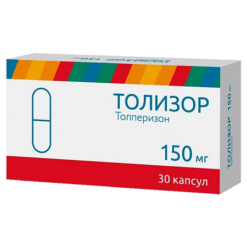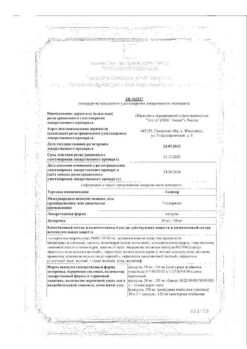No products in the cart.
Tolizor, 50 mg capsules 30 pcs
€1.00
Out of stock
(E-mail when Stock is available)
Description
Pharmacotherapeutic group: myorelaxant of central action.
ATX code: M03BX04
Pharmacological properties.
Indications
Indications
Symptomatic treatment of spasticity in adults due to stroke.
Pharmacological effect
Pharmacological effect
Pharmacotherapeutic group: centrally acting muscle relaxant.
ATX code: М03ВХ04
Pharmacological properties
Special instructions
Special instructions
The most common adverse reactions are hypersensitivity reactions.
Allergic reactions range from mild skin to severe systemic, including anaphylactic shock. Symptoms of an allergic reaction: redness, rash, urticaria, itching, angioedema (Quincke’s edema), tachycardia, hypotension and shortness of breath.
Female patients with hypersensitivity reactions to other drugs or a history of allergic reactions are at higher risk.
In cases of known hypersensitivity to lidocaine, increased caution should be exercised when using tolperisone due to possible cross-reactions.
Patients should be alert for any symptoms of hypersensitivity. If symptoms occur, you should immediately stop taking tolperisone and consult a doctor immediately. Tolperisone should not be re-prescribed after an episode of hypersensitivity to a drug containing it.
Impact on the ability to drive vehicles and machinery
Tolisor does not affect the ability to drive vehicles and machinery. Patients who experience dizziness, drowsiness, impaired attention, convulsions, blurred vision, or muscle weakness while taking the drug should consult a doctor.
Active ingredient
Active ingredient
Tolperisone
Composition
Composition
Active substances: Tolperisone hydrochloride 50 mg
Excipients: microcrystalline cellulose – 55.22 mg, lactose monohydrate (milk sugar) – 34.33 mg, croscarmellose sodium – 6.32 mg, hypromellose – 1.58 mg, citric acid monohydrate – 1.5 mg, magnesium stearate – 1.05 mg.
Pregnancy
Pregnancy
Pregnancy
Experimental studies on animals did not reveal the teratogenic effect of tolperisone. Due to the lack of significant clinical data, tolperisone should not be used during pregnancy (especially in the first trimester), unless the expected benefit clearly justifies the potential risk to the fetus.
Breastfeeding period
Since there is no data on the excretion of tolperisone in breast milk, the use of the drug during breastfeeding is contraindicated.
Contraindications
Contraindications
hypersensitivity to any of the components of the drug;
myasthenia gravis;
age under 18 years;
breast-feeding;
lactose intolerance, lactase deficiency, glucose-galactose malabsorption.
Side Effects
Side Effects
The safety profile of tolperisone is confirmed by data from use in more than 12,000 patients. According to these data, the most common disorders were disorders of the skin and subcutaneous tissues, general disorders, and disorders of the nervous system and gastrointestinal tract.
In the post-registration period, hypersensitivity reactions accounted for about 50-60% of all adverse reactions. Most adverse reactions were not serious and resolved on their own. Life-threatening hypersensitivity reactions have been reported very rarely.
Adverse reactions are listed below according to MedDRA classification and frequency: uncommon (≥1/1000, <1/100), rare (≥1/10000, <1/1000), very rare (<1/10000), frequency unknown (cannot be estimated based on available data).
From the blood and lymphatic system: very rarely – anemia, lymphadenopathy.
From the immune system: rarely – hypersensitivity reactions, anaphylactic reactions; very rarely – anaphylactic shock.
From the side of metabolism and nutrition: infrequently – anorexia; very rarely – polydipsia.
Mental disorders: infrequently – sleep disturbance, insomnia; rarely – weakness, depression; very rarely – confusion.
From the nervous system: infrequently – headache, dizziness, drowsiness; rarely – attention deficit disorder, tremor, convulsions, malaise, paresthesia, lethargy.
From the organ of vision: rarely – decreased visual acuity.
From the organ of hearing and labyrinthine disorders: rarely – tinnitus, vertigo.
From the cardiovascular system: infrequently – arterial hypotension; rarely – angina pectoris, tachycardia, palpitations, flushing of blood to the face; very rarely – bradycardia.
From the respiratory system: rarely – shortness of breath, nosebleeds, rapid breathing.
From the digestive system: uncommon – abdominal discomfort, dyspepsia, diarrhea, dry mouth, nausea; rarely – pain in the epigastric region, constipation, flatulence, vomiting.
From the liver and biliary tract: rarely – moderate liver failure.
From the skin and subcutaneous tissues: rarely – allergic dermatitis, increased sweating, itching, skin rash, urticaria.
From the musculoskeletal system: infrequently – muscle weakness, muscle pain, pain in the extremities; rarely – discomfort in the limbs; very rarely – osteopenia.
From the urinary system: rarely – enuresis, proteinuria.
General disorders and reactions at the injection site: uncommon – asthenia, discomfort, feeling tired; rarely – a feeling of intoxication, a feeling of heat, irritability, thirst; very rarely – chest discomfort.
From laboratory parameters: rarely – hyperbilirubinemia, changes in the activity of liver enzymes, thrombocytopenia, leukocytosis; very rarely – hypercreatininemia.
*Angioedema, including swelling of the face and lips, has been reported during post-marketing monitoring (frequency unknown).
If any of the reactions indicated in the instructions are aggravated or any other undesirable reactions not specified in the instructions are noted, the patient should inform the doctor.
Interaction
Interaction
Studies of pharmacokinetic drug interactions with the marker substrate of the CYP2D6 isoenzyme dextromethorphan have shown that simultaneous use of tolperisone can increase the blood levels of drugs that are predominantly metabolized by the CYP2D6 isoenzyme (thioridazone, tolterodine, venlafaxine, atomoxetine, desipramine, dextromethorphan, metoprolol, nebivolol, perphenazine).
In laboratory experiments on human liver microsomes and human hepatocytes, no significant inhibition or induction of other CYP isoenzymes (CYP2B6, CYP2C8, CYP2C9, CYP2C19, CYP1A2, CYP3A4) was detected.
Due to the diversity of tolperisone’s metabolic pathways, an increase in tolperisone exposure is not expected with concomitant use of CYP2D6 substrates and/or other drugs.
The bioavailability of tolperisone decreases when taken on an empty stomach.
Despite the fact that tolperisone is a centrally acting drug, its sedative effect is very low. When used simultaneously with other centrally acting muscle relaxants, the dose of tolperisone should be reduced.
Tolperisone enhances the effect of niflumic acid, therefore, with simultaneous use, a reduction in the dose of niflumic acid or other NSAIDs should be considered.
Overdose
Overdose
There is limited data on tolperisone overdose. In preclinical acute toxicity studies, high doses of tolperisone caused ataxia, tonic-clonic seizures, dyspnea, and respiratory paralysis. Tolperisone does not have a specific antidote. In case of overdose, symptomatic and supportive treatment is recommended.
Storage conditions
Storage conditions
The drug should be stored out of the reach of children, protected from light at a temperature not exceeding 25°C.
Shelf life
Shelf life
3 years. Do not use after the expiration date stated on the package.
Manufacturer
Manufacturer
Ozon, Russia
Additional information
| Shelf life | 3 years. Do not use after the expiration date stated on the package. |
|---|---|
| Conditions of storage | The drug should be kept out of reach of children, protected from light at a temperature not exceeding 25 ° C. |
| Manufacturer | Ozon, Russia |
| Medication form | capsules |
| Brand | Ozon |
Other forms…
Related products
Buy Tolizor, 50 mg capsules 30 pcs with delivery to USA, UK, Europe and over 120 other countries.
















